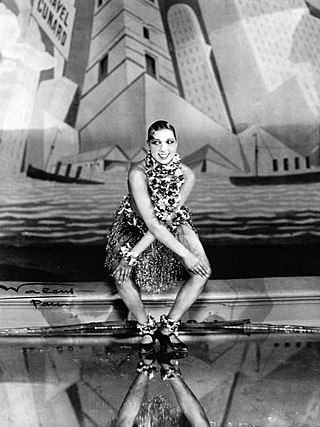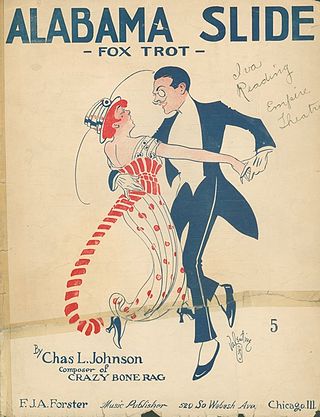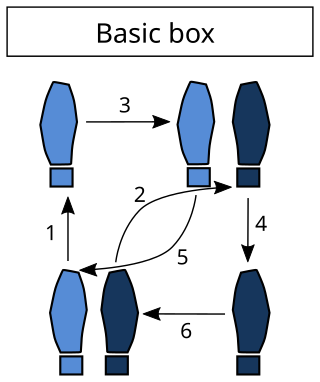
Ballroom dance is a set of European partner dances, which are enjoyed both socially and competitively around the world, mostly because of its performance and entertainment aspects. Ballroom dancing is also widely enjoyed on stage, film, and television.
In some types of partner dance, lead and follow are designations for the two dancers' roles in a dance pairing. The leader is responsible for guiding the couple and initiating transitions to different dance steps and, in improvised dances, for choosing the dance steps to perform. The leader communicates choices to the follower, and directs the follower by means of subtle physical and visual signals, thereby allowing the pair to be smoothly coordinated.

The Charleston is a dance named after the harbor city of Charleston, South Carolina. The rhythm was popularized in mainstream dance music in the United States by a 1923 tune called "The Charleston" by composer/pianist James P. Johnson, which originated in the Broadway show Runnin' Wild and became one of the most popular hits of the decade. Runnin' Wild ran from 28 October 1923 through 28 June 1924. The Charleston dance's peak popularity occurred from mid-1926 to 1927.
Dance moves or dance steps are usually isolated, defined, and organized so that beginning dancers can learn and use them independently of each other. However, more complex movements are influenced by musicality and lyrical relevance to express emotions or refer to a message. Dance moves tend to emphasize the concepts of lead and follow and connection.

The foxtrot is a smooth, progressive dance characterized by long, continuous flowing movements across the dance floor. It is danced to big band music. The dance is similar in its look to waltz, although the rhythm is in a 4
4 time signature instead of 3
4. Developed in the 1910s, the foxtrot reached its height of popularity in the 1930s and remains practiced today.

The volta is an anglicised name for a dance for couples that was popular during the later Renaissance period. This dance was associated with the galliard and done to the same kind of music. Its main figure consisted of a turn and lift in a sort of closed position, which could be done either to the right or to the left. It is also called La volta, Volta, Volte. Spelling variants include la volta and levolto; its name is la volte in French and la volta in Italian. It was considered at first to be risque and controversial. Although the dance was known at the court of Elizabeth I, the popular notion that Elizabeth and her favourite Lord Robert Dudley regularly performed the volta has been repudiated.

A redowa is a dance of Czech origin with turning, leaping waltz steps that was popular in European ballrooms.

The schottische is a partnered country dance that apparently originated in Bohemia. It was popular in Victorian era ballrooms as a part of the Bohemian folk-dance craze and left its traces in folk music of countries such as Argentina, Finland, France, Italy, Norway ("reinlender"), Portugal and Brazil, Spain, Sweden, Denmark, Mexico, and the United States, among other nations. The schottische is considered by The Oxford Companion to Music to be a kind of slower polka, with continental-European origin.

Country–western dance encompasses any of the dance forms or styles which are typically danced to country-western music, and which are stylistically associated with American country and/or western traditions. Many are descended from dances brought to the United States by immigrants from the United Kingdom and Europe as early as the 1700s, which became integrated into American popular culture. Country dancing is also known as "kicker dancing" in Texas.
This is a list of dance terms that are not names of dances or types of dances. See List of dances and List of dance style categories for those.
Because ballet became formalized in France, a significant part of ballet terminology is in the French language.

The quickstep is a light-hearted dance of the standard ballroom dances. The movement of the dance is fast and powerfully flowing and sprinkled with syncopations. The upbeat melodies that quickstep is danced to make it suitable for both formal and informal events. Its origins are in combination of slow foxtrot combined with the Charleston, a dance which was one of the precursors to what today is called swing dancing.
The Hustle is a catch-all name for some disco dances which were extremely popular in the 1970s. Late 1970s, Bump, Hustle, Watergate and Spank were popular. It mostly refers to the unique partner dance done in nightclubs to disco music. Hustle has steps in common with Mambo and Salsa and basic steps are somewhat similar to Euro dance style Discofox, which emerged at about the same time and is more familiar in various European countries. Modern partner hustle is sometimes referred to as New York hustle, however, its original name is the Latin hustle.
The grapevine is a dance figure in partner dancing that shares a common appearance, with some variation, in ballroom, club, and folk dances. It includes side steps and steps across the support foot. The step is used, for example, in the foxtrot, polka, Electric Slide and hustle as well as in freestyle aerobics.

Box step is a basic dance step named after the pattern it creates on the floor, which is that of a square or box. It is used in a number of American Style ballroom dances: rumba, waltz, bronze-level foxtrot. While it can be performed individually, it is usually done with a partner. This is the most common dance step in the waltz. In international standard dance competition, there is a similar step called closed change.

The cha-cha-cha, is a dance of Cuban origin. It is danced to cha-cha-cha music introduced by the Cuban composer and violinist Enrique Jorrin in the early 1950s. This rhythm was developed from the danzón-mambo. The name of the dance is an onomatopoeia derived from the shuffling sound of the dancers' feet when they dance two consecutive quick steps that characterize the dance.
The country/western two-step, often called the Texas two-step or simply the two-step, is a country/western dance usually danced to country music in common time. "Traditional [Texas] two-step developed, my theory goes, because it is suited to fiddle and guitar music played two-four time with a firm beat [found in country music]. One-two, one-two, slide-shuffle. The two-step is related to the polka, the Texas waltz, and the jitterbug.
The Texas two-step is the same step known to ballroom dancers as the international fox-trot. Except for the one-step, which is just that, most Texas dances are variations of a two-step, also called a half-step, which is simply a step-close-step. The Texas two-step is generally done with two long steps and a step-close-step to two-four time. Speeded up, it's a shuffle or double shuffle, but still a two-step.

The chassé is a dance step used in many dances in many variations. All variations are triple-step patterns of gliding character in a "step-together-step" pattern. The word came from ballet terminology.
The Collegiate Shag is a partner dance done primarily to uptempo swing and pre-swing jazz music. It belongs to the swing family of American vernacular dances that arose in the 1920s and 30s. It is believed that the dance originated within the African American community of the Carolinas in the 1920s, later spreading across the United States during the 1930s. The shag is still danced today by swing dance enthusiasts worldwide.











